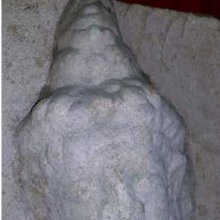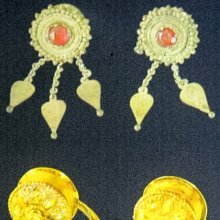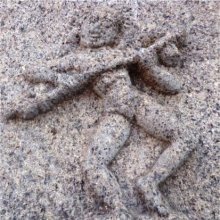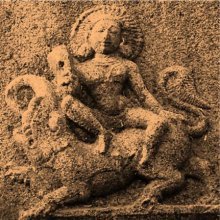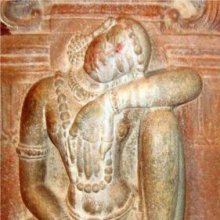Earring, Ear-ring: 2 definitions
Introduction:
Earring means something in Hinduism, Sanskrit, the history of ancient India. If you want to know the exact meaning, history, etymology or English translation of this term then check out the descriptions on this page. Add your comment or reference to a book if you want to contribute to this summary article.
Images (photo gallery)
(+31 more images available)
In Hinduism
Natyashastra (theatrics and dramaturgy)
Source: Shodhganga: Elements of Art and Architecture in the Trtiyakhanda of the Visnudharmottarapurana (natya)Ear-rings were commonly used as Ornaments (in Indian Dramas) as conveyed through the Alaṃkāra division of Āhāryābhinaya: one of the four divisions of Abhinaya or “ways to convey or represent one’s emotion to others”, according to the Viṣṇudharmottarapurāṇa, an ancient Sanskrit text which (being encyclopedic in nature) deals with a variety of cultural topics such as arts, architecture, music, grammar and astronomy.—Alaṃkāra deals with the decoration of garlands and ornaments. In the Nāṭyaśāstra four kinds of ornaments and five kinds of garlands are accepted. In the Sanskrit dramas ornaments like ear-rings, bracelets, head-gears etc. are seen to be collected from nature. This is informed in many of the Sanskrit dramas.

Natyashastra (नाट्यशास्त्र, nāṭyaśāstra) refers to both the ancient Indian tradition (shastra) of performing arts, (natya—theatrics, drama, dance, music), as well as the name of a Sanskrit work dealing with these subjects. It also teaches the rules for composing Dramatic plays (nataka), construction and performance of Theater, and Poetic works (kavya).
India history and geography
Source: Singhi Jain Series: Ratnaprabha-suri’s Kuvalayamala-katha (history)Earrings ornaments (and necklaces) were commonly found in the Sleeping chamber (of young ladies) in Ancient India, as depicted in the Kathās (narrative poems) such as Uddyotanasūri in his 8th-century Kuvalayamālā (a Prakrit Campū, similar to Kāvya poetry).—The Kuvalayamala (779 A.D.) is full of cultural material which gains in value because of the firm date of its composition. [...] Page 83.3-9: Here is the description of the house or the sleeping chambers of young ladies which were beautified for the reception of their husbands. The select items in this list are as follows: [e.g., putting on the śṛṅgāṭaka and valakkhala necklaces and round earrings ornaments;] [...]

The history of India traces the identification of countries, villages, towns and other regions of India, as well as mythology, zoology, royal dynasties, rulers, tribes, local festivities and traditions and regional languages. Ancient India enjoyed religious freedom and encourages the path of Dharma, a concept common to Buddhism, Hinduism, and Jainism.
See also (Relevant definitions)
Starts with: Earring plant.
Full-text (+573): Kundala, Kundali, Avatamsa, Tatanka, Karnaveshtaka, Uttamsa, Karnandu, Karnaveshtakika, Kundaladharana, Dantapatra, Akarnaveshtakika, Karnika, Kubra, Tongalabali, Karnaveshtana, Nagakundala, Karnadarpana, Ratnakarnika, Vatamsa, Jhumaka.
Relevant text
Search found 145 books and stories containing Earring, Ear-ring; (plurals include: Earrings, rings). You can also click to the full overview containing English textual excerpts. Below are direct links for the most relevant articles:
The Tattvasangraha [with commentary] (by Ganganatha Jha)
Verse 661-663 < [Chapter 11 - On ‘Quality’ as a Category]
Verse 670 < [Chapter 11 - On ‘Quality’ as a Category]
Verse 949 < [Chapter 16 - Examination of the Import of Words]
Manasara (English translation) (by Prasanna Kumar Acharya)
Chapter 54 - The altar (śakti-lakṣaṇa)
Chapter 49 - The crowns (mauli) and coronation (abhiṣeka)
Chapter 51 - The Triad (trimūrti: Brahmā, Viṣṇu, and Maheśa/Śiva)
Manusmriti with the Commentary of Medhatithi (by Ganganatha Jha)
Verse 4.36 < [Section IX - Personal Cleanliness]
Verse 10.113 < [Section XIII - The Brāhmaṇa in Times of Distress]
Verse 9.11 < [Section I - Husband and Wife]
The Religion and Philosophy of Tevaram (Thevaram) (by M. A. Dorai Rangaswamy)
Chapter 4.6 - (l) Shiva’s ornamentation < [Volume 2 - Nampi Arurar and Mythology]
Nayanar 70-71: Sadaiya (Cataiyanar) and Isaignaniyaar (Icainaniyar) < [Volume 4.1.1 - A comparative study of the Shaivite saints the Thiruthondathogai]
Chapter 45 - Thirukadaiyur or Tirukkatavur (Hymn 54) < [Volume 3.4 - Pilgrim’s progress: with Paravai]
Vakyapadiya of Bhartrihari (by K. A. Subramania Iyer)
Verse 3.7.115 < [Book 3 - Pada-kāṇḍa (7): Sādhana-samuddeśa (On the Means)]
Verse 3.7.27 < [Book 3 - Pada-kāṇḍa (7): Sādhana-samuddeśa (On the Means)]
Verse 3.7.121 < [Book 3 - Pada-kāṇḍa (7): Sādhana-samuddeśa (On the Means)]
Puranic encyclopaedia (by Vettam Mani)
Related products

